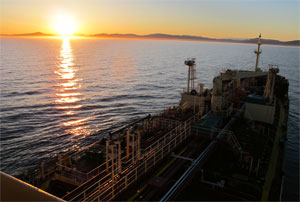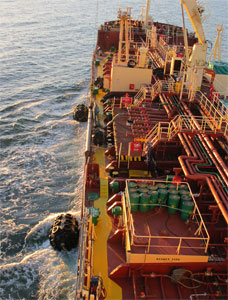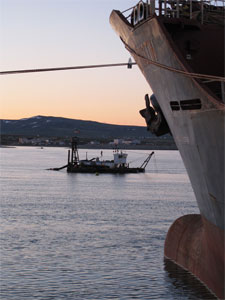The area of responsibility for the Alaska Marine Pilots is huge. Their pilotage area begins in the Gulf of Alaska west of Kodiak Island and includes the Alaska Peninsula and Aleutian Islands. It continues north to encompass Alaska’s coast along the Bering and Chukchi seas and then turns east along the Beaufort Sea as far as the Canadian border.
On the morning of June 19, Capt. Richard Entenmann, president of the pilots’ group, was aboard the 382-foot tanker Harbour Kristin just offshore from Nome. This put him and the ship about 150 miles south of the Arctic Circle.
His job would be to bring the tanker with a load of diesel fuel into the port of Nome. With its load, the ship was drawing 17 feet. The harbor is about 22 feet deep near the entrance, but near the berthing area the depths drop to 19 feet.
Entenmann would have to maneuver the tanker without the help of a conventional docking tug. Instead, he would have the assistance of a 76-foot tug, Naniq, designed as the power unit of an ATB. Rated at 1,800 hp and equipped with conventional props, this boat would lack the power and maneuverability of a modern azimuthing-stern-drive docking tug.
“This isn’t up their alley,” Entenmann said of the tug and its crew. “It’s an unconventional use of this type of vessel.”
But that fact did not faze him. In fact, this trip would be a fairly typical day for an Alaska Marine Pilot operating in a small outport lacking the modern infrastructure pilots have come to expect — and insist on for reasons of safety — in more developed ports to the south.
 |
|
Harbour Kristin approaching the jetties that mark the entrance to Nome. The dock is visible off the port bow. |
In one sense, the operation on this morning would be unusual for Alaska. The weather was beautiful: bright sun with moderate wind and seas. That did not mean that Entenmann could afford to be complacent.
“When you get weather like this, usually it gets worse. Seldom does it work the other way,” he said.
This would be Entenmann’s first time aboard Harbour Kristin, and over the next few days, he would guide the tanker in and out of Nome twice. Harbour Kristin would be acting as a lightering vessel, taking on loads of diesel fuel from a larger tanker stationed offshore and then delivering that fuel to Nome.
Nome is located on the northern shore of Norton Sound, an arm of the Bering Sea running from west to east. As Harbour Kristin made its approach, it would be heading north, while the winds would be blowing about 8 knots out of the west. If the currents were running parallel to the shoreline in the same direction, Entenmann would have to guard against getting set to the east.
“I will have to give it some oomph if I get set too far to the east,” he explained.
Nome is a small, but crowded harbor. Most of the vessels docked or pulled up on shore there are small hydraulic dredges used to suck up sand bearing traces of gold. Once inside the narrow confines of the harbor, Entenmann would have to be careful to stay clear of the dredges scattered about.
 |
|
Entenmann, on the bridge wing, communicates with an assist tug, in this case the power unit of a Vitus Marine ATB. |
“I have to start slamming on the brakes as I come through the jetty,” he said. “It’s a little harbor that they fill up with dredges. There’s not much room to move around.”
On this first trip, a special concern for Entenmann would be confirming the ship’s maneuvering capabilities. Given that the ship would have only one assist vessel, and not a true assist tug at that, the bow thruster would play a crucial role. As the ship approached the jetties, Entenmann turned to Capt. Antonio Cascano, the tanker’s master, and asked, “So, captain, is the bow thruster ready to go? We’re going to need it.”
With the wind blowing from port and the ship preparing to come to the dock on that side, Entenmann had directed Naniq to take up a position to starboard forward of midships, where it could counter the wind, which tends to blow the ship away from the dock.
Uncertain about how the bow thruster would perform, Entenmann asked the ship’s master, “Do you think the bow thruster is strong enough? Maybe we will put the tug on the stern.” Then he advised the captain, “I am going to play with it a bit” to see how the thruster performed.
At 0826 with the ship making 6.2 knots, Entenmann ordered “dead slow ahead,” followed by a stop-engines command six minutes later. With the ship’s speed now down to 5.2 knots, he issued a series of speed and helm orders to keep the ship moving ahead at about that speed, then alerted the captain, “In a minute I’m going to want thrust to port.”
At 0840, he began slowing the ship further, ordering slow astern and then dead slow astern, before calling for thruster to port. Two minutes later came “stop engines” and “stop thruster.”
The thrusters had done their job. The ship came to rest just off the dock aft of where it would tie up. “We have to slide forward, maybe 16 meters forward,” he said. Over the radio, he told the tug, “Naniq, can you slide more to midships?” and, “Naniq, come in and push.”
 |
|
The pilot discusses initial entry in Nome with the master, Capt. Antonio Cascano. |
Using the tug to hold the ship against the dock and the ship’s winches to pull on the mooring lines, Entenmann guided the ship toward its appointed spot.
“It’s much slower using the winch,” Entenmann said, “but safer.”
“You could have done this without a tug,” Entenmann said of the docking, but added, “it’s nice having this guy.”
“Outports have limited resources,” he observed. “You have to use them to their best potential. That said, there are a lot of limitations.”
At 0918, the ship was secured to the dock. “Perfect, it worked out great. OK, captain, you can let the tug go,” Entenmann said, his work for the day done.
The Alaska Marine Pilots are based in Dutch Harbor in the Aleutian chain, over 700 miles south of Nome. Entenmann is one of nine pilots who belong to the organization. The bulk of their work is performed in the Aleutians in support of the commercial fishing industry.
 |
|
Entenmann, using the ship’s bow thruster and the tug, eases the tanker toward the dock on June 19. The ship was delivering a cargo of diesel fuel. |
Capt. David Arzt, who is vice president of the pilots’ group, said the pilots perform approximately 1,000 ship moves a year. Many involve guiding cargo ships coming to the Aleutians to pick up cargo from fish-processing plants or fish-processing vessels, including containerships.
In terms of value of fish landed in 2013, Dutch Harbor ranked as the No. 2 port in the United States, at just under $200 million, according to the National Oceanic and Atmospheric Administration. And 40 miles from Dutch Harbor, Akutan is home to the largest fish-processing plant in the country, according to Arzt.
Some of the most intensive commercial fishing occurs during the winter months. For example, the pollock and cod fisheries start in January and continue through October. That means the pilots regularly encounter extreme winter wind and sea conditions. “Seventy to 90 knot winds are not atypical here,” Arzt said.
In the Aleutians, the combination of steep mountains and narrow bays and valleys produces sudden violent winds known as williwaws. “Strong winds build up on one side of a mountain and cascade down the other,” said Arzt.
The williwaws seem to embody the character of the weather in the Aleutians: violent, but often of short duration. “We work with the weather here,” Arzt explained. “You need to wait a short period of time and the weather could change for the better or for the worse.”
Some of the ships the pilots move are container vessels as long as 900 to 950 feet. These ships, with their large sail areas, are very susceptible to high winds. The solution, according to Arzt, is patience that may require delays of “just a few hours or a day.”
 |
|
Just after midnight on June 21, the sun continues to hover over the horizon, as Harbour Kristin approaches Nome with a second delivery of diesel fuel. |
Piloting in this part of the world presents another problem that most mariners don’t have to deal with: inaccurate charts. “A lot of the soundings in some of these outports we service go back many, many years … That makes them suspect,” he said. To counter that uncertainty, the pilots “stay along your established and familiar routes.”
While the pilots’ group is highly dependent on one industry — fishing — there are signs of change. The oil and gas industry wants to tap the offshore reserves that have been identified in the Arctic. And while the initial efforts came to an abrupt halt after a Shell drilling rig ran aground in 2012 near Kodiak Island, the oil company may resume operations soon. “We’re waiting to see what the 2015 plan might be,” Arzt said.
The steep drop in oil prices during 2014 may cause the oil companies to reconsider moving ahead with exploration in the Arctic in the short term, but over the long term it is a near certainty that offshore oil operations in the region will resume.
Alaska is also seeing some growth in expedition cruise vessels.
With the retreat of sea ice in the summer, the Arctic is beginning to attract passenger vessels: 300-foot to 400-foot cruise ships have been transiting to and from the Northwest Passage during their summer operating season in Alaskan waters. Arzt noted that plans exist to bring a 1,100-passenger vessel through the Northwest Passage in 2016. That would mean transiting Canadian waters on the east and crossing into U.S. waters north of Alaska, where the vessel would be required to take on an Alaska Marine Pilot.
 |
|
Harbour Kristin, with its large fenders still in place, moves away from a larger tanker following an offshore transfer of cargo in which the two ships were rafted together. |
Entenmann, a 1980 California Maritime grad who started with the Alaska Marine Pilots as a trainee in 1997, is well aware of the impending changes in his group’s pilotage area. “These places may open up,” he said. “We do want the business. We recognize the risks. This is just a neat place. You don’t want to see the change. You know it’s coming. … What can be done to make it right?”
A big part of that answer will depend on the competence of the Alaska Marine Pilots.
“We’re trying to protect the area and its environment,” Entenmann said. “Everything has to go right. We still do things that aren’t done anywhere else.”
He is highly conscious of the special challenges posed by the areas where he and his fellow pilots work. “I always prepare for the worst. That’s why there are no surprises. You’re prepared,” Entenmann said. “It always seems to pan out, knock on wood. We knock on wood a lot.”
Just after midnight on Saturday, June 21, Entenmann was back on the bridge of Harbour Kristin. The tanker had just taken on a load of diesel fuel during an offshore transfer from the tanker Antwerp. Now Harbour Kristin had released its lines to the larger tanker, maneuvered clear and was heading back to the Nome dock.
 |
|
Just beyond the docked tanker, a hydraulic dredge sucks up gold-bearing sediment. Congestion created by the gold dredges poses potential hazards for larger vessels. |
“Nice job, captain, coming away from that vessel,” Entenmann said to Harbour Kristin’s master.
On this night the winds were almost dead astern. That would simplify his entrance through the jetties and approach to the dock. And on this day, the longest day of the year, visibility would not be a problem.
Naniq emerged from the jetties. At 0135, Entenmann called out, “Captain, stand by to heave a line to the tug.”
With Naniq pulling gently from the stern and the bow thruster pushing to port, Harbour Kristin slowly angled toward the dock.
Then Entenmann ordered Naniq to push from amidships while the thruster reversed direction. “Now I can torque the bow back out,” Entenmann explained.
When the ship came parallel to the dock, Naniq continued to push while the thruster reversed again to nudge the bow toward the dock. At 0158, the ship came to rest against the pier.

